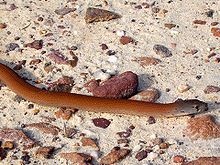- Pygopus lepidopodus
-
Scaly-foot 
Scalyfoot at Ku-ring-gai Chase National Park, Australia Scientific classification Kingdom: Animalia Phylum: Chordata Class: Reptilia Order: Squamata Family: Pygopodidae Genus: Pygopus Species: P. lepidopodus Binomial name Pygopus lepidopodus
Bernard Germain de Lacépède 1804The Common Scaly-foot is a widespread species of legless lizard in the Pygopodidae family[1]. It is endemic to Australia.
Contents
Habit
Mostly active at dusk or dawn (crepuscular), though can be nocturnal after high daytime temperatures. Lives in long grasses, heaths and woodlands. Most often seen on warm mornings, foraging for food. When threatened, the Scalyfoot flashes its thick fleshy tongue, in an apparent mimicry of snakes. Usually two eggs laid per clutch.[2]
Diet
The diet is a variety of invertebrates such as burrowing spiders[3]. There are reports of the Scaly-foot also eating other lizards in captivity, and vegetable matter [4], with a preference for bananas.
Distribution
Mostly in the southern and eastern parts of Australia. Though isolated populations occur in semi arid southern Queensland and tropical wet Queensland[5]. A common species.
Description
Snake like in appearance. Up to 80 cm in length with a noticeable "keel" or ridge on the top of the lizard. Variable in colours and pattern. Occasionally grey with black spots.[6] Sometimes coppery brown with a grey tail. Other patterns and variations occur. Prominent limb flaps may be seen on close inspection, hence the name "scaly foot".
Captivity
Considered an easy to keep species[7], a license is required to keep the Scaly-foot as a pet in Australia.

References
- ^ A Complete Guide to Reptiles of Australia - Steve Wilson & Gerry Swan ISBN 1 876334 72 X page 122
- ^ http://www.environment.nsw.gov.au/wildlifelicences/ReptileLicensingOutline.htm
- ^ http://www.jstor.org/pss/1564125
- ^ http://www.smuggled.com/feepyg1.htm
- ^ A Complete Guide to Reptiles of Australia - Steve Wilson & Gerry Swan ISBN 1 876334 72 X page 122
- ^ A Complete Guide to Reptiles of Australia - Steve Wilson & Gerry Swan ISBN 1 876334 72 X page 122
- ^ http://www.environment.nsw.gov.au/wildlifelicences/ReptileLicensingOutline.htm
- A Complete Guide to Reptiles of Australia - Steve Wilson & Gerry Swan ISBN 1 876334 72 X page 122
- http://museumvictoria.com.au/discoverycentre/infosheets/lizards-found-in-victoria/common-scaly-foot/
- http://www.jstor.org/pss/1564125
- http://books.google.com.au/books?id=qhrnAAAAMAAJ&pg=PA417&lpg=PA417&dq=Pygopus+lepidopodus&source=bl&ots=W095bdkgpG&sig=dLoilPfqYgFdBlfVbrGT5wFw0V4&hl=en&ei=f5tbS9r6EJWekQXgnKWdAg&sa=X&oi=book_result&ct=result&resnum=6&ved=0CBoQ6AEwBTgU#v=onepage&q=Pygopus%20lepidopodus&f=false

This lizard article is a stub. You can help Wikipedia by expanding it.
